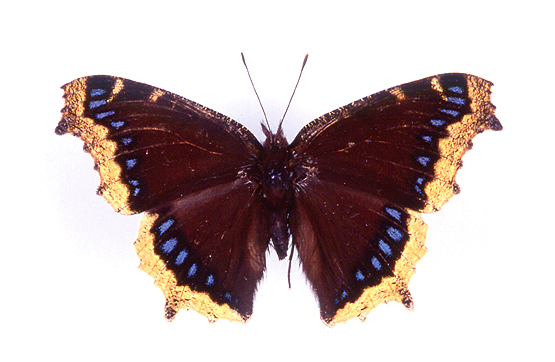Mourning Cloak Butterfly (Nymphalis antiopa)
Pricing: Dead (spread, as pictured): $30-$40 depending on quality
Geographic Range: Most of the Northern Hemisphere, south to northern South America
View: Top View Sex: Non-dimorphic Size: Wingspan: .7-8.5 cm

Image Copyright 2003
Barbara Strnadova
Although Nymphalis antiopa presumably got its common name “Mourning Cloak” from the somber coloring of its wings, the British name “Camberwell Beauty” is much more fitting. A beautiful and distinctive butterfly with a huge geographic range, it can be found throughout most of Canada south of the Arctic tundra, down through much of the U.S.A. (it is very rare in peninsular Florida) and all the way down to northern South America. It also ranges across much of Eurasia, making it one of the few Holarctic butterflies. Although individual specimens from far-flung locations all look alike, specimens from northern Canada and Alaska tend to be smaller than those found elsewhere. These have been called subspecies “hyperborea” but size is extremely variable so hyperborea is most likely not a true subspecies. There are two broods of Nymphalis antiopa in the southern part of its range and one in the north. The northern brood either migrates south in the fall or over-winters as adults, hidden inside hollow trees or nestled within deadfalls and other debris. They are the first butterflies to emerge in spring and can actually be found flying about on warm days in March, sometimes while there is still snow on the ground! The adults that over-winter can live as long as 10 or 11 months – incredibly long for a butterfly. Adult Mourning Cloaks rarely visit flowers for nectar. They prefer tree sap, especially that of oaks, and can be found feeding, head downward on the trunks of trees. They are also fond of fermenting fruit and can be attracted with bait. While they prefer woodlands, especially where intersected by riparian habitat, they can be found anywhere that their host plants occur - including parks and suburbs. Their larvae feed on the foliage of willows (Salix spp.), American elm (Ulmus americana), cottonwood (Populus deltoides), aspen (Populus tremuloides), paper birch (Betula papyrifera), and hackberry (Celtis occidentalis). Eggs are laid in late spring, in clusters. Caterpillars are blue-black with a row of red spots running down their back and are covered in numerous white speckles and branched spines. Caterpillars live in a communal web and feed together on young leaves. The group breaks up when they wander off to pupate. They emerge as adults in June or July and after feeding briefly will then estivate until the fall. When autumn arrives, they re-emerge to feed again in order to store up energy for their long, winter hibernation.